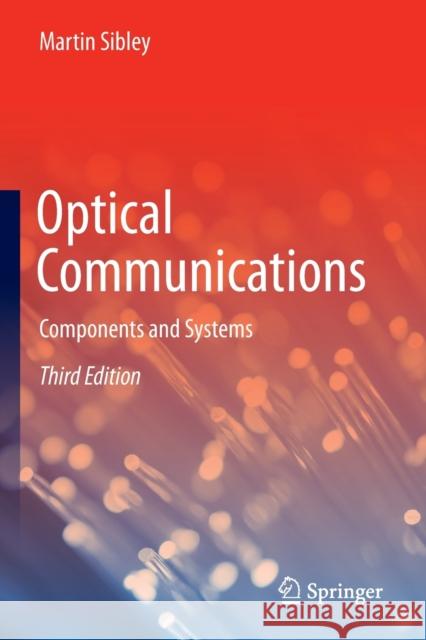Optical Communications: Components and Systems » książka



Optical Communications: Components and Systems
ISBN-13: 9783030343583 / Angielski / Miękka / 2020 / 250 str.
Optical Communications: Components and Systems
ISBN-13: 9783030343583 / Angielski / Miękka / 2020 / 250 str.
(netto: 286,84 VAT: 5%)
Najniższa cena z 30 dni: 289,13
ok. 22 dni roboczych
Dostawa w 2026 r.
Darmowa dostawa!
Preface to third edition
List of symbols
1. Introduction
1.1 Historical background
1.2 The optical communications link
2. Optical fibre
2.1 Propagation of light in a dielectric
2.1.1 The wave equation
2.1.2 Propagation parameters
2.1.3 Group velocity and material dispersion
2.2 Propagation in a planar dielectric waveguide
2.2.1 Reflection and refraction at boundaries
2.2.2 Propagation modes – ray path analysis
2.2.3 Propagation modes – modal analysis
2.2.4 Modal dispersion – ray path analysis
2.2.5 Modal dispersion – modal analysis
2.2.6 Waveguide dispersion – ray path and modal analysis
2.2.7 Numerical aperture
2.3 Propagation in optical fibres
2.3.1 Propagation in step-index optical fibres
2.3.2 Dispersion in cylindrical waveguides
2.3.3 Step-index multimode fibre
2.3.4 Step-index single-mode fibre
2.3.5 Graded-index fibre
2.4 Calculation of fibre bandwidth
2.5 Attenuation in optical fibres
2.5.1 Impurity absorption
2.5.2 Rayleigh scattering
2.5.3 Material absorption
2.5.4 Electron absorption
2.5.5 PCS and all-plastic fibres
2.6 Fibre materials and fabrication methods
2.6.1 Materials
2.6.2 Modified Chemical Vapour Deposition (MCVD)
2.6.3 Fibre drawing from a preform
2.6.4 Fibre drawing from a double crucible
2.7 Connectors and couplers
2.7.1 Optical fibre connectors
2.7.2 Optical fibre couplers
3. Optical transmitters
3.1 Semiconductor diodes
3.1.1 Intrinsic semiconductor material
3.1.2 Extrinsic semiconductor material
3.1.3 The p-n junction diode under zero bias
3.1.4 The p-n junction diode under forward bias
3.2 Light emission in semiconductors
3.2.1 Direct and indirect band-gap materials
3.2.2 Rate equations
3.3 Heterojunction semiconductor light sources
3.4 Light emitting diodes (LEDs)
3.4.1 Surface emitting LEDs
3.4.2 Edge emitting LEDs (ELEDs)
3.4.3 Spectral characteristics
3.4.4 Modulation characteristics and conversion efficiency
3.5 Semiconductor laser diodes (SLDs)
3.5.1 Stimulated emission
3.5.2 Spectral characteristics
3.5.3 Modulation capabilities
3.5.4 SLD structures
3.6 Solid-state and gas lasers
3.6.1 Nd3 +:YAG lasers
3.6.2 HeNe lasers
3.7 Light-wave modulation
3.7.1 LED drive circuits
3.7.2 SLD drive circuits
3.7.3 External modulators
3.8 Fibre lasers
4. Photodiodes
4.1 V-I characteristics of photodiodes
4.2 Photoconduction in semiconductors
4.2.1 Photon absorption in intrinsic material
4.2.2 Photon absorption in reverse-biased p-n diodes
4.3 PIN photodiodes
4.4.1 Structure
4.3.2 Depletion layer depth and punch-through voltage
4.3.3 Speed limitations4.3.4 Photodiode circuit model
4.3.5 Long-wavelength PIN photodiodes
4.4 Avalanche photodiodes (APDs)
4.4.1 APD structures
4.4.2 Current multiplication
4.4.3 Speed limitations
4.5 Metal Semiconductor Metal (MSM) Photodiodes
4.6 Photodiode noise
4.6.1 PIN photodiode noise
4.6.2 APD noise
5. Introduction to Receiver Design
5.1 Fundamentals of noise performance
5.2 Digital receiver noise
5.2.1 Raised-cosine spectrum pulses
5.2.2 Determination of I2 and I3
5.2.3 Statistical decision theory
5.2.4 Photodiode noise
5.2.5 Timing extraction
5.3 Analogue receiver noise
5.4 Comparison of APD and PIN receivers
5.5 Measurement and prediction of receiver sensitivity
5.5.1 Measurement of receiver sensitivity
5.5.2 Prediction of receiver sensitivity
6. Preamplifier Design
6.1 High input impedance preamplifiers
6.1.1 Frequency response
6.1.2 Noise analysis
6.1.3 Dynamic range
6.1.4 Design example
6.2 Transimpedance preamplifiers
6.2.1 Frequency response
6.2.2 Noise analysis
6.2.3 Dynamic range
6.2.4 Design example
6.3 Common-collector front-end transimpedance designs6.3.1 Frequency response
6.3.2 Noise analysis
6.3.3 Design example
6.4 Boot-strapped common-collector front-end transimpedance designs
7. Current Systems and Future Trends
7.1 System design
7.2 Current Systems
7.3 Long-haul high data rate links
7.3.1 Optical fibre transmission bands
7.3.2 Advanced modulation techniques
7.3.3 Fibre amplifiers
7.3.4 Coherent detection
7.3.5 Wideband preamplifiers
7.3.6 Optical Solitons
7.4 Free-space optical communications7.5 Future trends
7.5.1 Fluoride based optical fibres
7.5.2 Graphene detectors
7.5.3 Optical wireless
7.5.4 Crystalline fibres7.5.5 Spatial Division Multiplexing (SDM)
7.5.6 Passive Optical Networks (PONs)
Dr Martin J.N. Sibley studied at the University of Huddersfield (then the Polytechnic of Huddersfield), UK, obtaining a BSc (Hons) in Electrical Engineering in 1981. He stayed on to do a PhD, conferred in 1984, researching preamplifiers for optical receivers. This work was sponsored by British Telecom Research Laboratories (BTRL) and resulted in the first preamplifier to be fabricated in IC form. A BTRL Research Fellowship followed, examining the practical design of a Digital Pulse Position Modulation (DPPM) coder and decoder. Theoretical predictions showed that DPPM could out-perform Pulse Code Modulation (PCM) and practical results obtained using the DPPM coder and decoder confirmed the predictions. He continues to research this area today.
In 1986 Martin joined the academic staff at the University of Huddersfield. His main research area is optical communications, in particular the practical implementation of Visible Light Communication (VLC) using high power LEDs, and coding schemes for highly dispersive optical links such as plastic optical fibre. He is also involved in research work concerned with the open-area detection of concealed weapons. He has acted as consultant to several blue-chip companies.
Martin has published over 80 conference and proceedings papers as well as four textbooks in the fields of electromagnetism, optical communications and telecommunications. He is a Member of the IET and a Fellow of the Higher Education Academy.
1997-2025 DolnySlask.com Agencja Internetowa
KrainaKsiazek.PL - Księgarnia Internetowa









